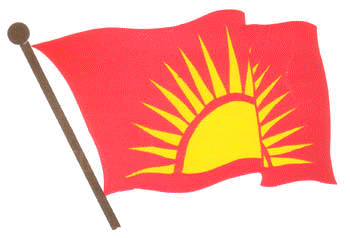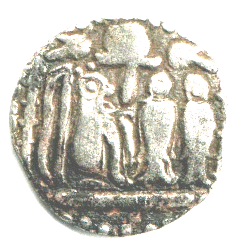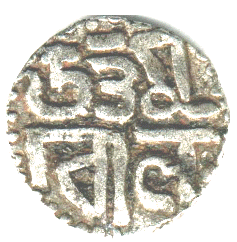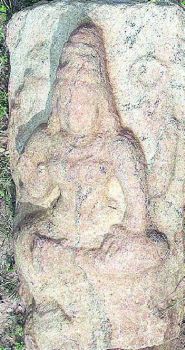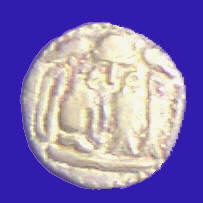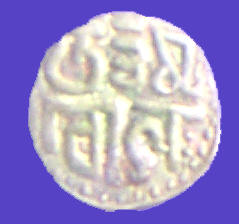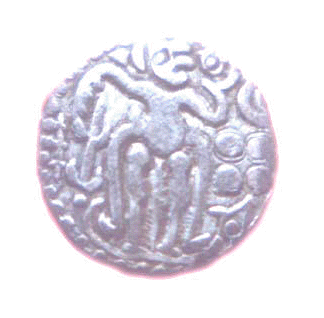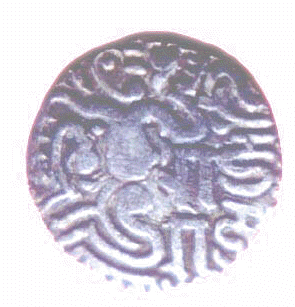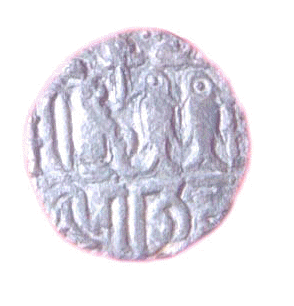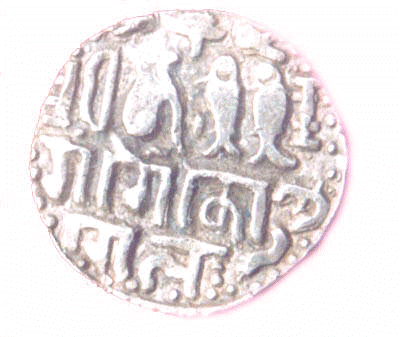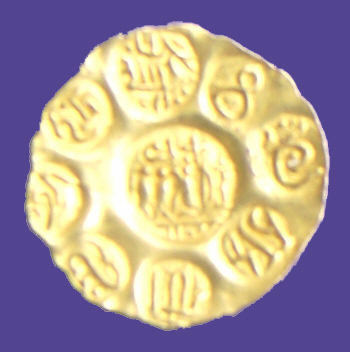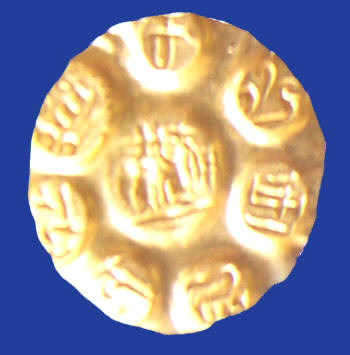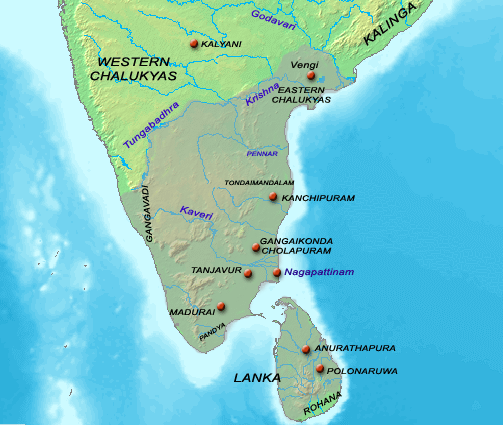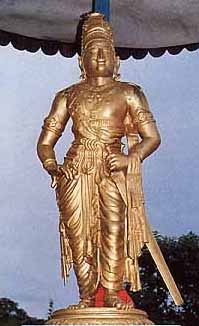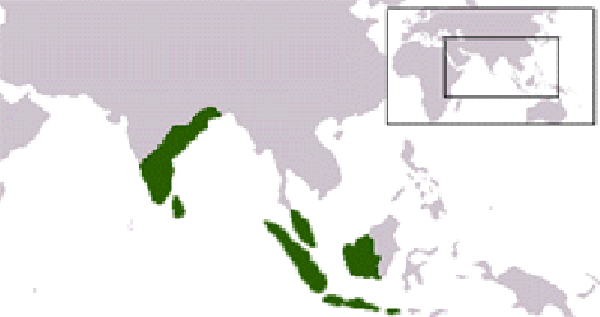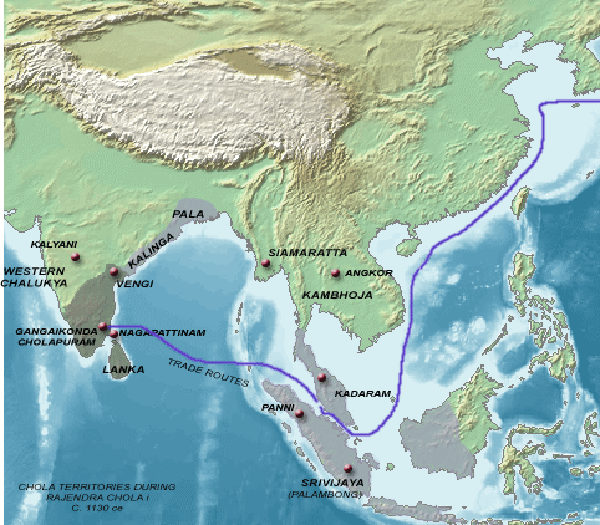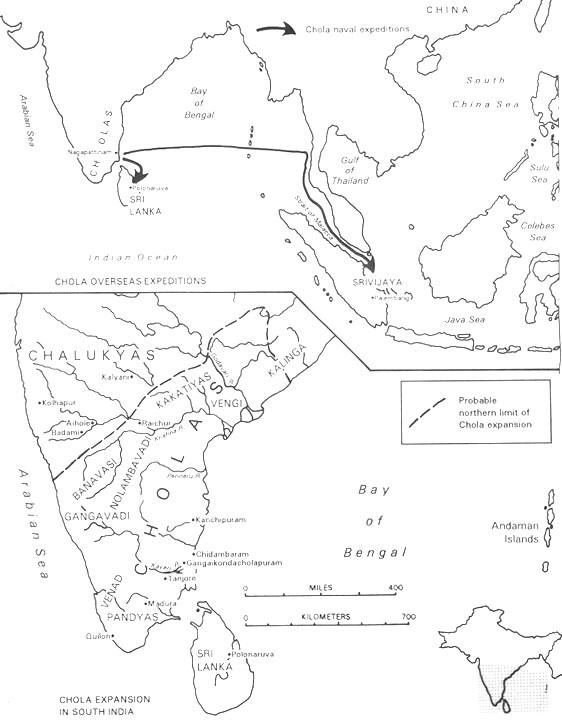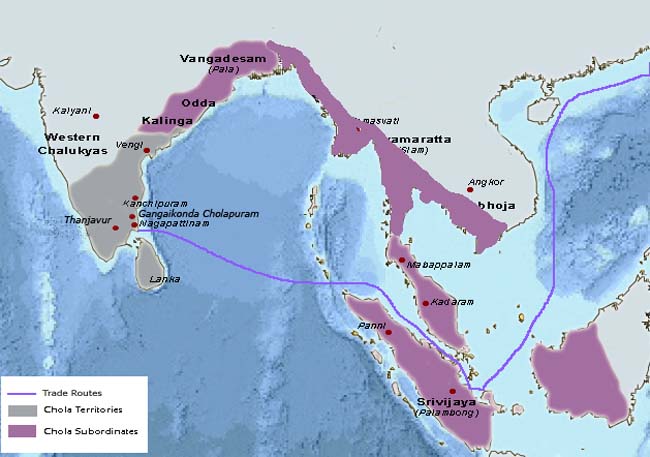- Etymology of Chola - History - Early Cholas - Interregnum - Medieval Cholas - Chalukya Cholas
- Chola country - Nature of government - Local government - Foreign trade - Chola society
- Art - Literature - Religion
The Chola Dynasty was a Tamil dynasty that ruled primarily in southern India until the 13th century. The dynasty originated in the fertile valley of the Kaveri River. Karikala Chola was the most famous among the early Chola kings, while Rajaraja Chola, Rajendra Chola and Kulothunga Chola I were notable emperors of the medieval Cholas.
The Cholas were at the height of their power during the tenth, eleventh and twelfth centuries. Under Rajaraja Chola I (Rajaraja the Great) and his son Rajendra Chola, the dynasty became a military, economic and cultural power in Asia.
The Chola territories stretched from the islands of the Maldives in the South to as far North as the banks of the Godavari River in Andhra Pradesh. Rajaraja Chola conquered peninsular South India, annexed parts of Sri Lanka and occupied the islands of the Maldives. Rajendra Chola sent a victorious expedition to North India that touched the river Ganga and defeated the Pala ruler of Pataliputra, Mahipala. He also successfully raided kingdoms of the Malay Archipelago. The power of the Cholas declined around the 12th century with the rise of the Pandyas and the Hoysala, eventually coming to an end towards the end of the 13th century.
The Cholas left behind a lasting legacy. Their patronage of Tamil literature and their zeal in building temples have resulted in some great works of Tamil literature and architecture. The Chola kings were avid builders and envisioned the temples in their kingdoms not only as places of worship but also as centres of economic activity. They pioneered a centralised form of government and established a disciplined bureaucracy.
There is very little information available regarding the origin of the Chola Dynasty. The antiquity of this dynasty is evident from the mentions in ancient Tamil literature and in inscriptions. Later medieval Cholas also claimed a long and ancient lineage to their dynasty.
Mentions in the early Sangam literature (c. 150)[2] indicate that the earliest kings of the dynasty antedated 100 CE. Parimelalagar, the annotator of the Tamil classic Tirukkural, mentions that this could be the name of an ancient clan. The most commonly held view is that this is, like Cheras and Pandyas, the name of the ruling family or clan of immemorial antiquity.[3][4]
On the history of Cholas there is very little authentic written evidence available. Historians during the past 150 years have gleaned a lot of knowledge on the subject from a variety of sources such as ancient Tamil Sangam literature, oral traditions, religious texts, temple and copperplate inscriptions. The main source for the available information of the early Cholas is the early Tamil literature of the Sangam Period.[5]
There are also brief notices on the Chola country and its towns, ports and commerce furnished by the Periplus of the Erythraean Sea (Periplus Maris Erythraei).[6] Periplus is a work by an anonymous Alexandrian merchant, written in the time of Domitian (81 � 96) and contains very little information of the Chola country.
Writing half a century later, the geographer Ptolemy gives more detail about the Chola country, its port and its inland cities.[7] Mahavamsa, a Buddhist text, recounts a number of conflicts between the inhabitants of Ceylon and the Tamil immigrants.[8] Cholas are mentioned in the Pillars of Ashoka (inscribed 273 BCE � 232 BCE) inscriptions, where they are mentioned among the kingdoms which, though not subject to Ashoka, were on friendly terms with him.[9][10]
The etymology of the word Chola has been agreed upon by many historians and linguists and it has been confirmed to be derived from the Tamil word Sora or Chora. Moreover, numerous inscriptions confirm that the name of the Dynasty was Chora or Sora but pronounced as Chola.[11] The shift from 'r' to 'l' has also been validated and Sora or Chora in Tamil becomes Chola in Sanskrit and Chola or Choda in Telugu.[12][13][14]
|
||||||||||||||||||||||||||||||||||||||||||||||||||||||||||||
The history of the Cholas falls naturally into four periods: the early Cholas of the Sangam literature, the interregnum between the fall of the Sangam Cholas and the rise of the medieval Cholas under Vijayalaya (c. 848), the dynasty of Vijayalaya, and finally the Chalukya Chola dynasty of Kulothunga Chola I from the third quarter of the eleventh century.[15]
The earliest Chola kings of whom there is tangible evidence are mentioned in the Sangam literature. Scholars now generally agree that this literature belongs to the first few centuries of the common era.[2] The internal chronology of this literature is still far from settled, and at present a connected account of the history of the period cannot be derived. The Sangam literature is full of names of the kings and the princes, and of the poets who extolled them. Despite a rich literature that depicts the life and work of these people, these cannot be worked into connected history.
The Sangam literature is also full of legends about mythical Chola kings. The Cholas were looked upon as descended from the sun.[16] These myths speak of the Chola king Kantaman, a supposed contemporary of the sage Agastya, whose devotion brought the river Kaveri into existence.[17] Two names stand out prominently from among those Chola kings known to have existed, who feature in Sangam literature: Karikala Chola and Kocengannan. There is no sure means of settling the order of succession, of fixing their relations with one another and with many other princelings of about the same period.[18] Urayur (now in/part-of Thiruchirapalli) was their oldest capital.
Little is known about the transition period of around three centuries from the end of the Sangam age (c. 300) to that in which the Pandyas and Pallavas dominate the Tamil country. An obscure dynasty, the Kalabhras, invaded the Tamil country, displaced the existing kingdoms and ruled for around three centuries. They were displaced by the Pallavas and the Pandyas in the 6th century. Little is known of the fate of the Cholas during the succeeding three centuries until the accession of Vijayalaya in the second quarter of the ninth century.
Epigraphy and literature provide a few faint glimpses of the transformations that came over this ancient line of kings during this long interval. What is certain is that when the power of the Cholas fell to its lowest ebb and that of the Pandyas and Pallavas rose to the north and south of them,[19] this dynasty was compelled to seek refuge and patronage under their more successful rivals.[20]
The Pallavas and Pandyas seem to have left the Cholas alone for the most part; however, possibly out of regard for their reputation, they accepted Chola princesses in marriage and employed in their service Chola princes who were willing to accept it.[21] The Chinese pilgrim Xuanzang, who spent several months in Kanchipuram during 639 � 640 writes about the 'kingdom of Culi-ya'.[22] Numerous inscriptions of Pallavas, Pandyas and Chalukya of this period mention conquering 'the Chola country'.[23] Despite this loss in influence and power, it is unlikely that the Cholas lost total grip of the territory around Urayur, their old capital. Vijayalaya, when he rose to prominence hailed from this geographical area.
Around the 7th century, a Chola kingdom flourished in present-day Andhra Pradesh. These Telugu Cholas traced their descent to the early Sangam Cholas.[24] However, nothing definite is known of their connection to the early Cholas. It is possible that a branch of the Tamil Cholas migrated north during the time of the Pallavas to establish a kingdom of their own, away from the dominating influences of the Pandyas and Pallavas.
While there is little reliable information on the Cholas during the period between the early Cholas and Vijayalaya dynasties, there is an abundance of materials from diverse sources on the Vijayalaya and the Chalukya Chola dynasties. A large number of stone inscriptions by the Cholas themselves and by their rival kings, Pandyas and Chalukyas, and copper-plate grants, have been instrumental in constructing the history of Cholas of that period.[25]
Around 850, Vijayalaya rose from obscurity to take an opportunity arising out of a conflict between Pandyas and Pallavas,[26] captured Thanjavur and eventually established the imperial line of the medieval Cholas.[27]
The Chola dynasty was at the peak of its influence and power during the medieval period. Great kings such as Rajaraja Chola I and Rajendra Chola I occupied the throne, and through their leadership and vision took extended the Chola kingdom beyond the traditional limits of a Tamil kingdom. At its peak, the Chola Empire stretched from the island of Sri Lanka in the south to the Godavari basin in the north.[28] The kingdoms along the east coast of India up to the river Ganges acknowledged Chola suzerainty. Chola navies invaded and conquered Srivijaya in the Malayan archipelago.[29] The report on the conquest of Srivijaya however might be an exaggeration.[30]
Throughout this period, the Cholas were constantly troubled by the ever-resilient Sinhalas, who attempted to overthrow the Chola occupation of Lanka, Pandya princes who tried to win independence for their traditional territories, and by the growing ambitions of the Chalukyas in the western Deccan. This period saw constant warfare between the Cholas and these antagonists. A balance of power existed between the Chalukyas and the Cholas, and there was a tacit acceptance of the Tungabhadra River as the boundary between the two empires. However, the bone of contention between these two powers was the growing Chola influence in the Vengi kingdom.
Marital and political alliances between the Eastern Chalukya kings based around Vengi located on the south banks of the River Godavari began during the reign of Rajaraja following his invasion of Vengi. Rajaraja Chola's daughter married prince Vimaladitya. Rajendra Chola's daughter was also married to an Eastern Chalukya prince Rajaraja Narendra.
Virarajendra Chola's son Athirajendra Chola was assassinated in a civil disturbance in 1070 and Kulothunga Chola I ascended the Chola throne starting the Chalukya Chola dynasty. Kulothunga was a son of the Vengi king Rajaraja Narendra.
The Chalukya Chola dynasty saw very capable rulers in Kulothunga Chola I and Vikrama Chola; however, the decline of the Chola power practically started during this period. The Cholas lost control of the island of Lanka and were driven out by the revival of Sinhala power.
Around 1118 they lost the control of Vengi to Western Chalukya king Vikramaditya VI and Gangavadi (southern Mysore districts) to the growing power of Hoysala Vishnuvardhana, a Chalukya feudatory. In the Pandya territories, the lack of a controlling central administration prompted a number of claimants to the Pandya throne to cause a civil war in which the Sinhalas and the Cholas were involved by proxy. During the last century of the Cholas, a permanent Hoysala army was stationed in Kanchipuram to protect them from the growing influence of the Pandyas.
The Cholas, under Rajendra Chola III, experienced continuous trouble. At the close of the 12th century, the growing influence of the Hoysalas replaced the declining Chalukyas as the main player in the north. The local feudatories were also becoming sufficiently confident to challenge the central Chola authority.
One feudatory, the Kadava chieftain Kopperunchinga I, even held the Chola king as hostage for sometime. The Cholas were exposed to assaults from within and without. The Pandyas in the south had risen to the rank of a great power.
The Hoysalas in the west threatened the existence of the Chola empire. Rajendra tried to survive by aligning with the two powers in turn. At the close of Rajendra�s reign, the Pandyan Empire was at the height of prosperity and had taken the place of the Chola empire in the eyes of the foreign observers.
The last recorded date of Rajendra III is 1279. There is no evidence that Rajendra was followed immediately by another Chola prince. The Chola empire was completely overshadowed by the Pandyan empire, though many small chieftains continued to claim the title "Chola" well into the 15th century.
According to Tamil tradition, the old Chola country comprised the region that includes the modern-day Tiruchirapalli District, and the Thanjavur District in Tamil Nadu state. The river Kaveri and its tributaries dominate this landscape of generally flat country that gradually slopes towards the sea, unbroken by major hills or valleys. The river Kaveri, which was also known as Ponni (golden) river, had a special place in the culture of Cholas. The unfailing annual floods in the Kaveri marked an occasion for celebration, Adiperukku, in which the whole nation took part, from the king to the lowest peasant.
Kaverippattinam on the coast near the Kaveri delta was a major port town. Ptolemy knew of this and the other port town of Nagappattinam as the most important centres of Cholas.[31] These two cosmopolitan towns became hubs of trade and commerce and attracted many religious faiths, including Buddhism.[32] Roman ships found their way in to these ports. Roman coins dating from the early centuries of the common era have been found near the Kaveri delta.[33]
The other major towns were Thanjavur, Urayur and Kudanthai, now known as Kumbakonam. After Rajendra Chola moved his kingdom to Gangaikonda Cholapuram, Thanjavur lost its importance. The later Chola kings of the Chalukya Chola dynasty moved around their country frequently and made cities such as Chidambaram, Madurai and Kanchipuram their regional capitals.
In the age of the Cholas, the whole of South India was, for the first time, brought under a single government,[34] when a serious attempt was made to face and solve the problems of public administration. The Cholas system of government was monarchical, as in the Sangam age. However, there was little in common between the primitive and somewhat tribal chieftaincy of the earlier time, and the almost Byzantine royalty�Rajaraja Chola�and his successors with its numerous palaces, and the pomp and circumstance associated with the royal court.
Between 980, and c. 1150, the Chola Empire comprised the entire south Indian peninsula, extending east to west from coast to coast, and bounded to the north by an irregular line along the Tungabhadra river and the Vengi frontier. Although Vengi had a separate political existence, it was so closely connected to the Chola Empire that, for all practical purposes, the Chola dominion extended up to the banks of the Godavari river.[35]
Thanjavur and later Gangaikonda Cholapuram were the imperial capitals. However both Kanchipuram and Madurai were considered to be regional capitals, in which occasional courts were held. The king was the supreme commander and a benevolent dictator.[36] His administrative role consisted of issuing oral commands to responsible officers when representations were made to him.[37]
A powerful bureaucracy assisted the king in the tasks of administration and in executing his orders. Due to the lack of a legislature or a legislative system in the modern sense, the fairness of king�s orders dependent on the goodness of the man and in his belief in Dharma�a sense of fairness and justice. All Chola kings built temples and endowed great wealth to them. The temples acted not only as places of worship but as centres of economic activity, benefiting their entire community.[38]
Every village was a self-governing unit. A number of villages constituted a larger entity known as a Kurram, Nadu or Kottram, depending on the area. A number of Kurrams constituted a valanadu. These structures underwent constant change and refinement throughout the Chola period.[39]
Justice was mostly a local matter in the Chola Empire; minor disputes were settled at the village level. Punishment for minor crimes were in the form of fines or a direction for the offender to donate to some charitable endowment. Even crimes such as manslaughter or murder were punished with fines. Crimes of the state, such as treason, were heard and decided by the king himself; the typical punishment in these cases was either execution or the confiscation of property.[40]
The Cholas excelled in foreign trade and maritime activity, extending their influence overseas to China and Southeast Asia. Towards the end of the 9th century, southern India had developed extensive maritime and commercial activity. The Cholas, being in possession of parts of both the west and the east coasts of peninsular India, were at the forefront of these ventures. The Tang dynasty of China, the Srivijaya empire in the Malayan archipelago under the Sailendras, and the Abbasid Kalifat at Bagdad were the main trading partners.[42]
Chinese Song Dynasty reports record that an embassy from Chulian (Chola) reached the Chinese court in the year 1077, and that the king of the Chulien at the time was called Ti-hua-kia-lo.[43] It is possible that these syllables denote "Deva Kulo[tunga]" (Kulothunga Chola I). This embassy was a trading venture and was highly profitable to the visitors, who returned with 81,800 strings of copper coins in exchange for articles of tributes, including glass articles, and spices.[44]
A fragmentary Tamil inscription found in Sumatra cites the name of a merchant guild Nanadesa Tisaiyayirattu Ainnutruvar (literally, "the five hundred from the four countries and the thousand directions"), a famous merchant guild in the Chola country.[45] The inscription is dated 1088, indicating that there was an active overseas trade during the Chola period.
There is little information on the size and the density of the population during the Chola reign. The overwhelming stability in the core Chola region enabled the people to lead a very productive and contented life. There is only one recorded instance of civil disturbance during the entire period of Chola reign.[46] However, there were reports of widespread famine caused by natural calamities.
The quality of the inscriptions of the regime indicates a presence of high level of literacy and education in the society. The text in these inscriptions was written by court poets and engraved by talented artisans. Education in the contemporary sense was not considered important; there is circumstantial evidence to suggest that some village councils organized schools to teach the basics of reading and writing to children, although there is no evidence of systematic educational system for the masses.[47] Vocational education was through hereditary training in which the father passed on his skills to his sons. Tamil was the medium of education for the masses; Sanskrit education was restricted to the Brahmins. Religious monasteries (matha or gatika) were centers of learning, which were supported by the government.[48][49]
Under the Cholas, the Tamil country reached new heights of excellence in art, religion and literature. In all of these spheres, the Chola period marked the culmination of movements that had begun in an earlier age under the Pallavas. Monumental architecture in the form of majestic temples and sculpture in stone and bronze reached a finesse never before achieved in India.
The Cholas excelled in maritime activity in both military and the mercantile fields. Their conquest of Kadaram (Kedah) and the Srivijaya, and their continued commercial contacts with the Chinese Empire, enabled them to influence the local cultures. Many of the surviving examples of the Hindu cultural influence found today throughout the Southeast Asia owe much to the legacy of the Cholas.[50]
The Cholas continued the temple-building traditions of the Pallava dynasty and contributed significantly to the Dravidian temple design. They built numerous temples throughout their kingdom such as the Brihadeshvara Temple. Aditya I built a number of Siva temples along the banks of the river Kaveri. These temples were not on a large scale until the end of the 10th century.[51]
Temple building received great impetus from the conquests and the genius of Rajaraja Chola and his son Rajendra Chola I. The maturity and grandeur to which the Chola architecture had evolved found expression in the two temples of Thanjavur and Gangaikondacholapuram. The magnificent Siva temple of Thanjavur, completed around 1009, is a fitting memorial to the material achievements of the time of Rajaraja. The largest and tallest of all Indian temples of its time, it is at the apex of South Indian architecture.[52]
The temple of Gangaikondacholapuram, the creation of Rajendra Chola, was intended to exceed its predecessor in every way. Completed around 1030, only two decades after the temple at Thanjavur and in much the same style, the greater elaboration in its appearance attests the more affluent state of the Chola Empire under Rajendra.[53]
The Chola period is also remarkable for its sculptures and bronzes. Among the existing specimens in museums around the world and in the temples of South India may be seen many fine figures of Siva in various forms, such as Vishnu and his consort Lakshmi, and the Siva saints. Though conforming generally to the iconographic conventions established by long tradition, the sculptors worked with great freedom in the 11th and the 12th centuries to achieve a classic grace and grandeur. The best example of this can be seen in the form of Nataraja the Divine Dancer.[54]
The age of the Imperial Cholas (850�1200) was the golden age of Tamil culture, marked by the importance of literature. Chola inscriptions cite many works, and it is a tragedy that most of them have been lost to us,[55]
The revival of Hinduism from its nadir during the Kalabhras spurred the construction of numerous temples and these in turn generated Saiva and Viashnava devotional literature. Jain and Buddhist authors flourished as well, although in fewer numbers than in previous centuries. Jivaka-chintamani by Tirutakkadevar and Sulamani by Tolamoli are among notable by non-Hindu authors. The art of Tirutakkadevar is marked by all the qualities of great poetry.[56] It is considered as the model for Kamban for his masterpiece Ramavatharam.
Kamban flourished during the reign of Kulothunga Chola III.[57] His Ramavatharam is the greatest epic in Tamil Literature, and although the author states that he followed Valmiki, his work is no mere translation or simple adaptation of the Sanskrit epic: Kamban imports into his narration the colour and landscape of his own time; his description of Kosala is an idealised account of the features of the Chola country.
Jayamkondar�s masterpiece Kalingattuparani is an example of narrative poetry that draws a clear boundary between history and fictitious conventions. This describes the events during Kulothunga Chola I�s war in Kalinga and depicts not only the pomp and circumstance of war, but the gruesome details of the field. The famous Tamil poet Ottakuttan was a contemporary of Kulothunga Chola I. Ottakuttan wrote Kulothunga Solan Ula a poem extolling the virtues of the Chola king. He served at the courts of three of his successors.
The impulse to produce devotional religious literature continued into the Chola period and the arrangement of the Saiva canon into 11 books was the work of Nambi Andar Nambi, who lived close to the end of 10th century. However, relatively few works on Vaishnavite religion were composed during the Chola period, possibly because of the apparent animosity towards the Vaishnavites by the Chaluka Chola monarchs.[58]
In general, Cholas were the adherents of Hinduism. Throughout their history, they were not swayed by the rise of Buddhism and Jainism as were the kings of the Pallava and Pandya dynasties. Even the early Cholas followed a version of the classical Hindu faith. There is evidence in Purananuru for Karikala Chola�s faith in the Vedic Hinduism in the Tamil country.[59] Kocengannan, another early Chola, was celebrated in both Sangam literature and in the Saiva canon as a saint.
Later Cholas were also staunch Saivites, although there was a sense of toleration towards other sects and religions. Parantaka I and Sundara Chola endowed and built temples for both Siva and Vishnu. Rajaraja Chola I even patronised Buddhists, and built the Chudamani Vihara (a Buddhist monastery) in Nagapattinam at the request of the Srivijaya Sailendra king.[60]
During the period of Chalukya Cholas, there were instances of intolerance towards Vaishnavites�especially towards Ramanuja, the leader of the Vaishnavites. This intolerance led to persecution and Ramanuja went into exile in the Chalukya country. He led a popular uprising that resulted in the assassination of Athirajendra Chola. Kulothunga Chola II is reported to have removed a statue of Vishnu from the Siva temple at Chidambaram. There is ample evidence, from the inscriptions, that Kulothunga II was a religious fanatic who wanted to upset the camaraderie between Hindu faiths in the Chola country.[61]
The history of the Chola dynasty has inspired many Tamil authors to produce literary and artistic creations during the last several decades. These works of popular literature have helped continue the memory of the great Cholas in the minds of the Tamil people. The most important work of this genre is the popular Ponniyin Selvan (The son of Ponni), a historical novel in Tamil written by Kalki Krishnamurthy. Written in five volumes, this narrates the story of Rajaraja Chola. Ponniyin Selvan deals with the events leading up to the ascension of Uttama Chola on the Chola throne. Kalki had cleverly utilised the confusion in the succession to the Chola throne after the demise of Sundara Chola. This book was serialised in the Tamil periodical Kalki during the mid 1950s. The serialisation lasted for nearly five years and every week its publication was awaited with great interest.
Kalki perhaps laid the foundations for this novel in his earlier historical romance Parthiban Kanavu, which deals with the fortunes of an imaginary Chola prince Vikraman who was supposed to have lived as a feudatory of the Pallava king Narasimhavarman I during the 7th century. The period of the story lies within the interregnum during which the Cholas were in eclipse before Vijayalaya Chola revived their fortune. Parthiban Kanavu was also serialised in the Kalki weekly during the early 1950s.
Sandilyan, another popular Tamil novelist, wrote Kadal Pura in the 1960s. It was serialised in the Tamil weekly Kumudam. Kadal Pura is set during the period when Kulothunga Chola I was in exile from the Vengi kingdom, after he was denied the throne that was rightfully his. Kadal Pura speculates the whereabouts of Kulothunga during this period. Sandilyan's earlier work Yavana Rani written in the early 1960s is based on the life of Karikala Chola. More recently, Balakumaran wrote the opus Udaiyar based on the event surrounding Rajaraja Chola's construction of the Brihadisvara Temple in Thanjavur. In January 2007, Kaviri mainthan - a novel set in the Chola period and a sequel to Ponniyin Selvan was written by Anusha Venkatesh, published by The Avenue Press.
There were stage productions based on the life of Rajaraja Chola during the 1950s and in 1973, Shivaji Ganesan acted in a screen adaptation of this play.
- ^ Not one of the numerous references that appear in Tamil literature tells us anything of its origin. The Telugu Cholas who claimed to have descended from the early Cholas adapted the lion crest.
- ^ a b The age of Sangam is established through the correlation between the evidence on foreign trade found in the poems and the writings by ancient Greek and Romans such as Periplus. See Nilakanta Sastri, K.A., History of South India, pp 106
- ^ See Tirukkural poem 955 (வழங்குவ துள்வீழ்ந்தக் கண்ணும் பழங்குடி/பண்பில் தலைப்பிரிதல் இன்று. The annotator Parimelazhagar writes "The charity of people with ancient lineage (such as the Cholas, the Pandyas and the Cheras) are forever generous in spite of their reduced means".
- ^ Other names in common use for the Cholas are Killi (கிள்ளி), Valavan (வளவன்) and Sembiyan (சேம்பியன்). Killi perhaps comes from the Tamil 'kil' (கிள்) meaning dig or cleave and conveys the idea of a digger or a worker of the land. This word often forms an integral part of early Chola names like Nedunkilli, Nalankilli and so on, but almost drops out of use in later times. Valavan is most probably connected with 'valam' (வளம்) � fertility and means owner or ruler of a fertile country. Sembiyan is generally taken to mean a descendant of Shibi � a legendary hero whose self-sacrifice in saving a dove from the pursuit of a falcon figures among the early Chola legends and forms the subject matter of the Sibi Jataka among the Jataka stories of Buddhism. See Nilakanta Sastri, K.A. The CōĻas, 1935. pp 19�20
- ^ The period covered by the Sangam poetry is likely to extend not longer than five or six generations - Nilakanta Sastri, K.A. The CōĻas, 1935 pp 3
- ^ The Periplus refers to the region of the eastern seaboard of South India as Damirica - The Periplus of the Erythraean Sea (Ancient History source book).
- ^ Ptolemy mentions the town of Kaveripattinam (under the form Khaberis) - Proceedings, American Philosophical Society, vol. 122, No. 6, 1978.
- ^ See Mahavamsa eText - http://lakdiva.org/mahavamsa/
- ^ The Asokan inscriptions speak of the Cholas in plural, implying that, in his time, there were more than one Chola - Nilakanta Sastri, K.A. The CōĻas, 1935 pp 20
- ^ The Edicts of Ashoka, issued around 250 BCE by the Mauryan emperor Ashoka, mention the Cholas as recipients of his Buddhist prozelitism: "The conquest by Dharma has been won here, on the borders, and even six hundred yojanas (5,400�9,600 km) away, where the Greek king Antiochos rules, beyond there where the four kings named Ptolemy, Antigonos, Magas and Alexander rule, likewise in the south among the Cholas, the Pandyas, and as far as Tamraparni (Sri Lanka). (Edicts of Ashoka, 13th Rock Edict, S. Dhammika)."
- ^ Archaeological News A. L. Frothingham, Jr. The American Journal of Archaeology and of the History of the Fine Arts, Vol. 4, No. 1 (Mar., 1888), pp. 69-125
- ^ India in Classical Greek Writings By Baij Nath Puri
- ^ Journal of the Royal Asiatic Society of Great Britain and Ireland By Royal Asiatic Society of Great Britain and Ireland
- ^ "The name Coromandel is used for the east coast of India from Cape Comorin to Nellore, or from point Calimere to the mouth of Krihsna. The word is a corrupt form of Choramandala or the Realm of Chora, which is the Tamil form of the title of the Chola dynasty". - Sarojini Naidu's Select Poems, with an Introduction, Notes, and Bibliography for Further Study By A. N. Gupta, Satish Gupta
- ^ The direct line of Cholas of the Vijayalaya dynasty came to a bloody end with the assassination of Virarajendra Chola. Kulothunga Chola I a distant relation to the main Chola line through marriage ascended the throne in 1070.
- ^ "செங்கதிர்ச் செல்வன் திருக் குலம் விளக்கும்" - Manimekalai (poem 00-10)
- ^ See Manimekalai (22-030).
- ^ The only evidence for the approximate period of these early kings is the Sangam Literature and the synchronization with the history of Sri Lanka as given in the Mahavamsa. Gajabahu I who is said to be the contemporary of the Chera Senguttuvan is determined to belong to the 2nd century. This leads us to date the poems mentioning Senguttuvan and his contemporaries to belong to this period.
- ^ See Nilakanta Sastri, K.A. The CōĻas, 1935. pp 102
- ^ Pandya Kadungon and Pallava Simhavishnu overthrew the Kalabhras. Acchchutakalaba is likely the last Kalabhra king - Nilakanta Sastri, K.A. The CōĻas, 1935 pp 102
- ^ Periyapuranam, a Saiva religious work of 12th century tells us of the Pandya contemporary of the saint Tirugnanasambandar who had for his queen a Chola princess.
- ^ Nilakanta Sastri, K.A. The CōĻas, 1935 pp 102
- ^ Copperplate grants of the Pallava Buddhavarman(late 4th century) mention that the king as the 'underwater fire that destroyed the ocean of the Chola army' - Nilakanta Sastri, K.A. The CōĻas, 1935 pp 104�105 Simhavishnu (575�600) is also stated to have seized the Chola country. Mahendravarman I was called the 'crown of the Chola country' in his inscriptions. The Chalukya Pulakesin II in his inscriptions in Aihole states that he defeated the Pallavas and brought relief to the Cholas. - Nilakanta Sastri, K.A. The CōĻas, 1935 pp 105
- ^ KAN Sastri postulates that there was a live connection between the early Cholas and the Renandu Cholas of the Andhra country. The northward migration probably took place during the Pallava domination of Simhavishnu. Sastri also categorically rejects the claims that these were the descendants of Karikala Chola - Nilakanta Sastri, K.A. The CōĻas, 1935 pp 107
- ^ The Chola inscriptions followed the practice of prefacing the intended text with a historical recounting, in a poetic and ornate style of Tamil, of the main achievements of the reign and the decent of the king and of his ancestors - See South Indian Inscriptions
- ^ The opportunity for Vijayalaya arose during the battle of Sripurambayam between the Pallava ally Ganga Pritvipati and the Pandya Varaguna.
- ^ Vijayalaya invaded Thanjavur and defeated the Muttarayar king, feudatory of the Pandyas.
- ^ Rajendra Chola I completed the conquest of the island of Sri Lanka and captured the Sinhala king Mahinda V prisoner. See KAN Sastri, The Colas pp 194�210
- ^ The kadaram campaign is first mentioned in Rajendra's inscriptions dating from his 14th year. The name of the Srivijaya king was Sangrama Vijayatungavarman -Nilakanta Sastri, K.A. The CōĻas, 1935 pp 211�220
- ^ Stuart Munro-Hay. Nakhon Sri Thammarat - The Archaeology, History and Legends of a Southern Thai Town. Page 18. ISBN 9747534738
- ^ Ptolomy mentions the markets of Kaverippattinam as Chabaris Emporium in his Geographica.
- ^ The Buddhist work Milinda Panha dated to the early Christian era, mentions Kolapttna among the best-known sea ports on the Chola coast - Nilakanta Sastri, K.A. The CōĻas, 1935, pp 23
- ^ Nagaswamy, R. Tamil Coins - a study (1981) (http://tamilartsacademy.com/books/coins/cover.html)
- ^ The only other time when peninsular India would be brought under one umbrella before the Independence was during the Vijayanagara Empire (1336�1614)
- ^ Nilakanta Sastri, K.A. The CōĻas, 1935, pp 448
- ^ There were no legislature or controls on the executive. The king ruled by edicts, which generally followed dharma a culturally mediated concept of 'fair and proper' practice. See Nilakanta Sastri, K.A. The CōĻas, 1935 pp 451, 460�461
- ^ For example, Rajaraja is mentioned in the Layden copperplate grant to have issued an oral order for a gift to a Buddhist vihara at Nagapattinam, and his orders were written out by a clerk (...நாம் சொல்ல நம் ஓலை எழுதும்...) - Nilakanta Sastri, K.A. The CōĻas, 1935 pp 461
- ^ Some of the output of villages throughout the kingdom was given to temples that reinvested some of the wealth accumulated as loans to the settlements. The temple served as a centre for redistribution of wealth and contributed towards the integrity of the kingdom - John Keays, India a History, pp 217�218
- ^ Nilakanta Sastri, K.A. The CōĻas, 1935 pp 465
- ^ Nilakanta Sastri, K.A. The CōĻas, 1935 pp 477
- ^ See Nilakanta Sastri, K.A. (1955). A History of South India, pp 424�426
- ^ See Nilakanta Sastri, K.A. The CōĻas, 1935. pp 604
- ^ See Nilakanta Sastri, K.A. The CōĻas, 1935. pp 316
- ^ The Tamil merchants took glassware, camphor, sandalwood, rhinoceros horns, ivory, rose water, asafoetida, spices such as pepper, cloves, etc. See Nilakanta Sastri, K.A. A History of South India, pp 173
- ^ Tamil : நானாதேச திசையாயிரத்து ஐந்நூற்றுவர்
- ^ �during the short reign of Virarajendra Chola, which possibly had some sectarian roots.
- ^ 17th century Italian traveler Pietro Della Valle (1623) has given a vivid account of the village schools in South India. These accounts reflect the system of primary education in existence until the morder times in Tamil Nadu
- ^ Rajendra Chola I endowed a large college in which more than 280 students learnt from 14 teachers - Nilakanta Sastri, K.A. A History of South India, pp 293
- ^ The students studied a number of subjects in these colleges, including philosophy (anvikshiki), Vedas (trayi � the threefold Vedas of Rigveda, Yajurveda and Samaveda. The fourth Atharvaveda was considered a non-religious text.), economics (vartta), government (dandaniti), grammar, prosody, etymology, astronomy, logic (tarka), medicine (ayurveda), politics (arthasastra) and music. - Nilakanta Sastri, K.A. A History of South India, pp 292
- ^ The great temple complex at Prambanan in Indonesia exhibit a number of similarities with the South Indian architecture. See Nilakanta Sastri, K.A. The CōĻas, 1935 pp 709
- ^ See Nilakanta Sastri, K.A. (1955). A History of South India, pp 418
- ^ See Nilakanta Sastri, K.A. (1955). A History of South India, pp 421
- ^ Nagasamy R, Gangaikondacholapuram (1970)
- ^ The bronze image of nataraja at the Nagesvara Temple in Kumbakonam is the largest image known.
- ^ , including Rajarajesvara Natakam- a work on drama, Viranukkaviyam by one Virasola Anukkar, and Kannivana Puranam, a work of popular nature. - Nilakanta Sastri, K.A. The CōĻas, 1935 pp 663�664
- ^ Sindamani was based on Uttarapurana of Gunabhadra composed in 898.
- ^ Nilakanta Sastri, K.A. The CōĻas, 1935 pp 672
- ^ Purananuru (poem 224) movingly expresses his faith and the grief caused by his passing away.
- ^ The name of the Sailendra king was Sri Chulamanivarman. the Vihara was named 'Chudamani vihara' in his honour - Nilakanta Sastri, K.A. The CōĻas, 1935 pp 214
- ^ There is an inscription from 1160 that the custodians of Siva temples who had social intercourses with Vaishnavites would forfeit their property. - Nilakanta Sastri, K.A. The CōĻas, 1935 pp 645
References
- Nilakanta Sastri, K.A. The CōĻas, University of Madras, Madras, 1935 (Reprinted 1984).
- Nilakanta Sastri, K.A. A History of South India, OUP, New Delhi, 1955 (Reprinted 2002).
- Nagaswamy, R. Tamil Coins - a study, 1981.
- Nagasamy R, Gangaikondacholapuram, State Department of Archaeology, Government of Tamil Nadu, 1970
- Keay, John, India A History, Harper Collins Publishers, New Delhi, 2000.
- UNESCO World Heritage sites constructed by the Chola Empire: http://whc.unesco.org/pg.cfm?cid=31&id_site=250
